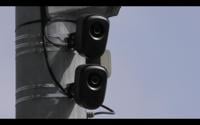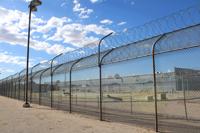
This article is a co-publishing effort between CALÓ News and Inadvertent.
The Santa Ana Police Department (SAPD) is tracking all drivers across the city using automated license plate readers (ALPR) and putting their information into a privately-owned national database. The ALPR systems, approximately 57 cameras purchased from private companies Flock Safety and Motorola, indiscriminately track law-abiding residents almost-exclusively. According to a statistic provided by SAPD, a mere .02% of total scans within one week resulted in a connection to a criminal investigation. SAPD’s mass surveillance of the Santa Ana community comes as Immigration and Customs Enforcement (ICE) looks to create a 24/7 social media surveillance team in Santa Ana at the Pacific Enforcement Response Center (PERC), according to ICE’s draft plans and reporting by WIRED.
In May, a Santa Ana city council majority voted in favor of mass tracking of Santa Ana residents by entering into contracts with Flock and Motorola. The move came despite a growing number of cities across the country abandoning their agreements with Flock in support of civil rights as well as the neighboring Orange County Sheriff’s Department and Los Angeles Police Department illegally sharing ALPR data with ICE. The council majority – Santa Ana Police Officers Association-aligned members Thai Viet Phan, Valerie Amezcua, Phil Bacerra and David Penaloza – lauded the mass surveillance technology as a way to assist SAPD in criminal investigations. According to a study by the Municipal Technical Advisory Service at the University of Tennessee, there is little empirical evidence that suggests surveillance cameras keep communities safe.
Council members Jessie Lopez, Johnathan Hernandez and Benjamin Vazquez voted against the mass surveillance technology contracts.
“It diverts the conversation away from actually talking about measures that actually increase public safety and improves the quality of our lives,” Yadi Younse, an organizer with Oakland Privacy, said, “if law enforcement and politicians are utilizing technology as a crutch or are very eager to implement this technology solution, then that means that they don’t have to work on thinking through and discussing and finding solutions to actually improve the actual crime issues that are happening.”
At the October 7 council meeting, SAPD Chief Robert Rodriguez falsely stated that the ALPR cameras simply “read a license plate on vehicles…nothing else.” Inadvertent obtained data samples from Motorola’s ALPR system revealing what Motorola’s ALPR system collects: date, time and coordinates of the scan, as well as photographs of the entire vehicle, a driver or occupants and the background of where they are driving. Simply stated, the cameras capture anything in plain sight and allow police to see what you do every day when you leave your home. They operate 24/7, according to Flock’s website.
Rodriguez and the SAPD PIO unit did not respond to multiple requests for comment.
The cameras capture personal information of individuals rather than just license plates, according to Flock’s own materials, Motorola’s data and Younse. “They actually capture an image of the entire vehicle and anything that happens to be in the image that is captured by these cameras. And so that includes the color of the vehicle, and identifying features like bumper stickers that say you’re in favor of reproductive rights, or that you’re LGBTQ, or that you’re of a certain religion, among many, many other things,” she said.
According to both contracts, Flock and Motorola are authorized to share Santa Ana residents’ data with unidentified third parties without consent of the public. Flock’s contract also states that the company can use the data to train machine learning algorithms, also known as artificial intelligence (AI).
At the May meeting, Lopez spoke at length about her concerns with the technology. In a recent phone interview, she stated, “One of the issues that I talked about on the dais was my constituents not giving consent to the city council or to the city for their privacy to be lost. And it is nearly impossible to get that back for them.”
SAPD is also withholding the locations of the cameras. On September 9, SAPD denied a request for records relating to the installation of the Flock cameras. Lopez also stated that the city did not answer her question about the locations of the cameras. However, at the recent State of the City address, Rodriguez – stumbling with his words – said that the cameras were installed “across key corridors” in the city. So far, Inadvertent has located four intersections within Santa Ana city limits that Flock ALPR cameras were installed in: Main Street & 17th Street, Bristol Street & 17th Street, Harbor Boulevard & MacArthur Boulevard, and Buffalo Avenue & Broadway. The ALPR systems are typically on signal light poles on corners. They are black and feature a solar panel installed above them.
The public can report Flock cameras on DeFlock, a free community resource.
After vehicles are scanned, the data collected is sent to national databases that police across the country access. Each instance the public is logged creates more data points, that, in aggregate, can tell police information such as where a resident often goes, who else frequents that location, where someone may shop, buy groceries, go to work, drop their kids off at, go to school at, or hang out with – all without any reasonable suspicion that the person is doing anything unlawful.
Younse, based in Pasadena, said, “There are cameras specifically outside of two of the dance studios I go to. And I go to the dance studios five or six days out of the week. And so if there was a camera by my house – and they are planning to install cameras close to where I live – they will be able to take an image every single time I’m going to that studio and that means that law enforcement will have a record of where I am at 6:30 PM, five to six days a week.”
SAPD’s ALPR policy states that they will store Flock data for one year and Motorola data for five years. It states that the data itself is not a public record because it may contain “confidential information,” which is at odds with Rodriguez’s claim that only license plates are captured. Furthermore, a 2017 California Supreme Court ruling established that ALPR data is disclosable under the state’s open records law with anonymization or other steps taken to protect the public’s privacy in mass disclosure.
SAPD did not answer a single question about Policy 436, their ALPR policy. The policy was created by another private company, Lexipol, who also did not respond to a request for comment.
Birds Of A Feather Flock Together
SAPD and Flock had been in communication since at least January 2025, according to text messages between Commander Gil Hernandez and Flock representative Larry Barsocchini.

“Hey Larry, happy new year,” wrote SAPD Commander Gil Hernandez on January 14, “Just a heads up, I gave your contact number to Carolyn Killian [sic] who is one of our property managers within the city. They are interested in purchasing ALPR cameras.”
According to the company’s website, Killion is a property manager at 4 Hutton Centre Drive, the property adjacent to ICE’s PERC at 3 Hutton Centre Drive. The city of Santa Ana also recently entered into a contract with Killion’s company, Ares Asset Management LLC, to lease space for an SAPD substation at 4 Hutton Centre Drive.
ICE’s draft plans show their social media surveillance teams, which make up part of the Targeting Operations Division (TOD) based at the PERC, will consist of sixteen people. TOD is part of ICE’s Enforcement and Removal Operations (ERO) – the same division that is snatching people away.
The team structure, according to the documents, is: a site lead, three senior analysts and twelve analysts. Their mission, according to ICE’s records, is to “identify and provide location information on individuals” and will “compile, analyze, organize, and transmit all information obtained to ICE personnel.”
“The contractor will research and analyze data from commercial and law enforcement databases as well as other publicly accessible, open-source, and social media platforms to support investigations and aid in targeting individuals for arrest in furtherance of ICE law enforcement missions,” records say.
Council member Bacerra did not respond to repeated requests for comment about the PERC located in his ward. His calendar shows that he met with Killion in December 2024 to discuss the substation adjacent to the PERC.
The city of Santa Ana and ICE have locked arms, again, by entering into these public-private partnerships: using contractors to spy on the community under the guise of law enforcement.
And the mayor is in denial about it.
“When I think about solutions to crime, those solutions don’t hurt other people in the process and they don’t perpetuate injustices,” said Lopez.












(0) comments
Welcome to the discussion.
Log In
Keep it Clean. Please avoid obscene, vulgar, lewd, racist or sexually-oriented language.
PLEASE TURN OFF YOUR CAPS LOCK.
Don't Threaten. Threats of harming another person will not be tolerated.
Be Truthful. Don't knowingly lie about anyone or anything.
Be Nice. No racism, sexism or any sort of -ism that is degrading to another person.
Be Proactive. Use the 'Report' link on each comment to let us know of abusive posts.
Share with Us. We'd love to hear eyewitness accounts, the history behind an article.